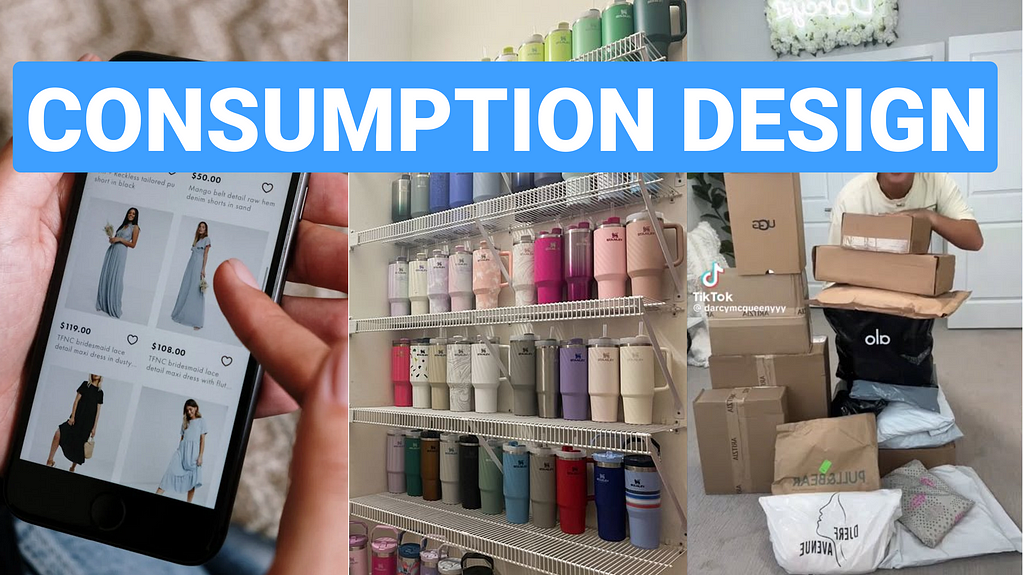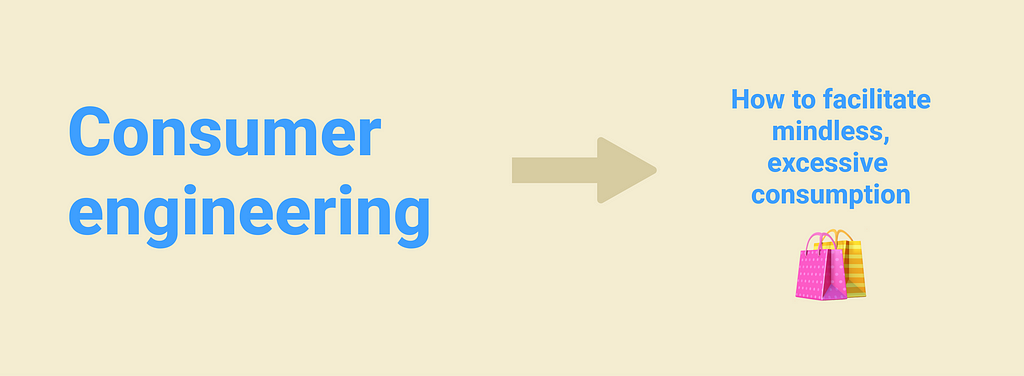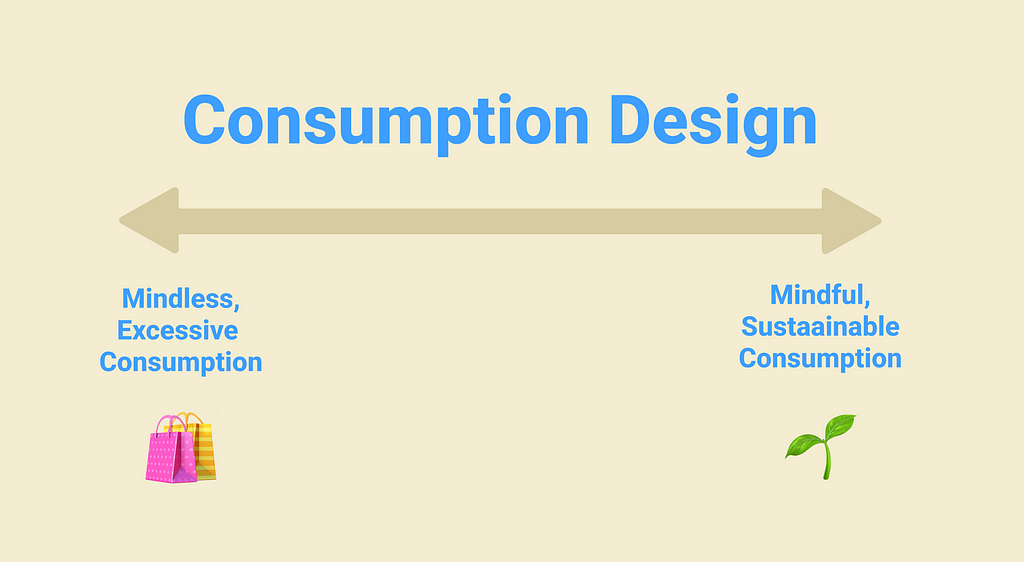As we are edging towards an unlivable planet one fast fashion haul at a time, it is overdue to recon with the impact of Consumption Design.

Everyday life has become one big consumerism fever dream. We are constantly tempted and pushed to buy stuff we don’t need or even want, by design.
Social media, once a place to connect, now a platform to sell, sell, and sell more. Instead of looking at pictures of your friends’ trip to Greece, you look at influencers promoting the season’s ‘must-have’ products. And what a coincidence, you can immediately buy that product from seamlessly integrated shopping interfaces. No need to think; just buy. The algorithms prioritising sales content and the complementing built-in shopping experiences are carefully designed to make consumption compelling, easy and well… thoughtless.
But you don’t need to use social media to experience pushy shopping experiences. E-commerce in general is designed to provoke mindless, impulse purchases. One-click-by buttons have come about specifically to minimise friction in the checkout process to “leave less time to rethink purchases.” Not to mention the meticulous use of social proof, urgency and other nudges to trigger reactive purchases.
When users are making buying decisions on a whim it is easy to spend more than they can afford. But worry not, buy-now-pay-later is here to save the day! Momentarily cash-strapped customers can now opt for a microloan without leaving the checkout process. Novel financing solutions are designed to facilitate excessive consumption even if it leads to crippling debt.
And finally, we need to mention that the products themselves we are so keen on accumulating are designed to break or go out of style quickly to keep us coming back to buy more or upgrade to the latest versions.
The bottom line is that products, services and experiences are designed to drive or support excessive consumption. This is Consumption Design.
What is Consumption Design?
Consumption Design is a term to encapsulate the power of design in influencing consumer behaviour. It encompasses a broad range of strategies and methods aimed at manipulating what and how much people buy.
Influencing consumption decisions through design is not a new phenomenon. Consumer engineering has existed for over a century, and it is the origin of Consumption Design.
A short intro to consumer engineering
In the 1920s, America faced a problem it had never faced before: overproduction. Factories had become too efficient in producing goods and consumers were too slow or poor to buy them. To solve this conundrum, the leaders of the economy choose to train people to become obedient consumers. In other words: engineer consumers.
“We must shift America from a needs, to a desires culture. People must be trained to desire, to want new things even before the old had been entirely consumed. We must shape a new mentality in America. Man’s desires must overshadow his needs.” — Paul Mazur, a partner at Lehman Brothers (See source)
If you are wondering, slowing down production to avoid manufacturing excess stuff wasn’t even considered an option. Earnest Elmo Calkins, the father of consumer engineering, argued that slowing down would mean “turning back the page to earlier and more primitive times when people got along with little and made everything last as long as possible.” What a horrid prospect. A clean planet and a slower life…how primitive.
Calkins was also the one who declared consumer engineering as the “new business science” where increased demand is created through artificial obsolescence and marketing:
“Goods fall into two classes, those we use, such as motor cars or safety razors, and those we use up, such as toothpaste and soda biscuits. Consumer engineers must see to it that we use up the kinds of goods we merely use.” — Earnest Elmo Calkins
Consumer engineers had the important task of “creating consumer demand through the appearance of product innovations, new colour variations, creating new applications and finding other ways of “making goods desirable.””
From Consumer Engineering to Consumption Design
During the past 100 years, we realised we can do more than artificial obsolescence and marketing to increase consumption. We have become experts in manipulating decision-making by exploiting psychological insights and mental shortcuts (nudging, urgency, social proof, etc). We mastered optimizing user flows to craft shopping environments that encourage impulse purchases. We have established and normalized more pervasive ways to create desire for non-essential products.
Consumer engineering, with a narrow focus on product design and marketing, has evolved into a more encompassing Consumption Design, that captures a variety of strategies and methods aimed at influencing consumer decisions.
Consumer engineering also had a narrow focus in the sense that it only considered how to increase consumption.

On the other hand, Consumption Design allows us to question the purpose, impact and ethics of influencing purchase decisions. Do we want to design for excessive, mindless consumption, or sustainable, mindful consumption?

Why you should care about Consumption Design
Primarily because you might be a Consumption Designer yourself and you need to understand the impact of your work.
Impact 1: People are fed up with overconsumption
The thing is, people are getting tired of being pushed to consume all the time. I’m talking about your users, the people you are designing for, the people who use your products.
- They complain that it has become too easy to buy stuff they don’t even want thanks to one-click buy buttons and seamless checkouts.
- They are upset that they go broke spending too much because of pushy or gamified shopping experiences.
- They are becoming fed up with influencers shoving useless, low-quality products down their audiences’ throats.
For a user-centred designer, these are clear indicators of user dissatisfaction and pain points. Seeing these, we should ask ourselves: how do we justify the push for excessive consumption when it makes our users distressed and unhappy?
Impact 2: The planet is in shambles
It is not only your direct user who is negatively impacted by all this unnecessary consumption but also the planet. The planet that you live on and that your kids and grandkids are going to live on.
The production and disposal of all the useless cr*p pollutes the planet contributing to climate change and other environmental problems. As conscious designers understanding our responsibility to use design for good, we should ask ourselves: how do we justify the push for excessive consumption when it so obviously harms the planet?
Impact 3: Exploitation along the supply chain
If a T-shirt is $5 in the store, how could the dozens of people who grew the cotton, sewed the t-shirt, packaged and delivered that T-shirt be fairly paid? Nohow. To produce the useless stuff as cheaply as possible (so that the company can maximize profit) people are exploited along the supply chain.
Regardless of which reason resonates with you the most, one thing is clear: designing for excessive consumption is harmful.
The takeaway
We live in a world designed to keep us in the consumption hamster wheel. As designers, we shape and build this world with the decisions we make. That is why it’s crucial that we recognise our impact and change course as soon as possible.
We need to start championing designing for mindful and sustainable consumption. Either by challenging practices at companies that design for excessive consumption or by choosing to use our skills and knowledge at companies that are already on the mission of sustainable consumption.
“Consumer culture had to be invented; designers helped invent it. If that’s the case, then we can invent something better. We don’t have a choice. As designers, we don’t have to wait. […] Instead of imagining how to make a better widget, we should be dreaming about remaking our willfully ignorant acceptance of consumer culture.” — Cliff Kuang — Designers helped get us into the climate crisis. Can they help get us out?
What now?
Please share this article with a friend or colleague! We need to raise awareness and start a discussion to ignite change and start designing for mindful and sustainable consumption. If you have ever been frustrated by mindless overconsumption, help spread the word about Consumption Desing.
Hi, I’m Anna, UX researcher, and advocate for mindful consumption by design. I post about this topic semi-regularly on LinkedIn if you want to follow, and I drive Kind Commerce to challenge pushy e-commerce designs.
![]()
Are you a Consumption Designer? was originally published in UX Collective on Medium, where people are continuing the conversation by highlighting and responding to this story.